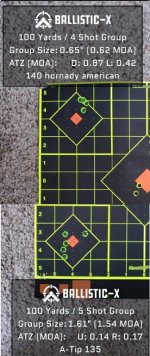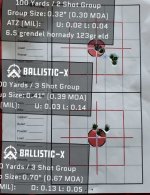So I ran up my first load of some of the 135gr 6.5 Creedmoor A-tip.
Strang 4 rounds vertically, one flier, 1.6" group @ 100yds (ran 2 other 5 shot groups that were similar). Load data was Hornady's recommended powder charge and OAL as a starting point, case capacity seemed ideal using RL-16.
Then, I shot 4 rounds of Hornady American Gunner BTHP 140gr (literally the cheapest thing at the gun store) and it did 0.6" group with 3 touching and one flier.
I then did 5 shots on the chono with my handloads (just a Caldwell chrono):
StdDev: 60 fps
ExSpread: 119 fps
Average: 2740 fps (i was going for 2725 fps)
I have been handloading for a like 6 years but this is my first attempt at the long-range/super-accurate loads (sub-moa type). Normally do bulk or hunting loads moa-ish.
I am trying to figure out why the high spread on chrono and stringing. If the chrono is accurate I am assuming my Velocity inconsistency is what causes the stringing, but not sure why...
I am using a Hornady single-stage
micrometer seating die, with the a-tip seat, digital powder measure
135gr A-tip, hornady brass, tried superformance and RL16 (both had similar chrono results), fed 210m primers
Tolerances:
Seating had +/- 0.002" (measuring off the bullet tip, I have ordered a comparator but didnt use one)
Powder was +/- 0.1 grain
Gun is a Bergara HMR, vortex ffp 6-24x50, benchrest using front bipod and rear bag.
Strang 4 rounds vertically, one flier, 1.6" group @ 100yds (ran 2 other 5 shot groups that were similar). Load data was Hornady's recommended powder charge and OAL as a starting point, case capacity seemed ideal using RL-16.
Then, I shot 4 rounds of Hornady American Gunner BTHP 140gr (literally the cheapest thing at the gun store) and it did 0.6" group with 3 touching and one flier.
I then did 5 shots on the chono with my handloads (just a Caldwell chrono):
StdDev: 60 fps
ExSpread: 119 fps
Average: 2740 fps (i was going for 2725 fps)
I have been handloading for a like 6 years but this is my first attempt at the long-range/super-accurate loads (sub-moa type). Normally do bulk or hunting loads moa-ish.
I am trying to figure out why the high spread on chrono and stringing. If the chrono is accurate I am assuming my Velocity inconsistency is what causes the stringing, but not sure why...
I am using a Hornady single-stage
micrometer seating die, with the a-tip seat, digital powder measure
135gr A-tip, hornady brass, tried superformance and RL16 (both had similar chrono results), fed 210m primers
Tolerances:
Seating had +/- 0.002" (measuring off the bullet tip, I have ordered a comparator but didnt use one)
Powder was +/- 0.1 grain
Gun is a Bergara HMR, vortex ffp 6-24x50, benchrest using front bipod and rear bag.


